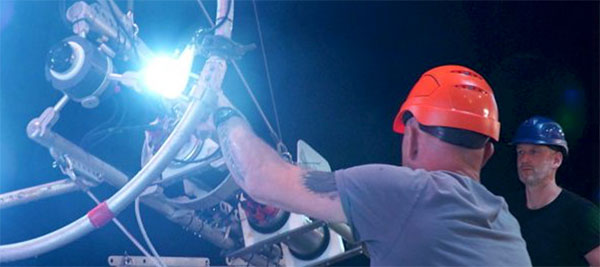
Exploring the open ocean
The open ocean is the largest habitat on this planet. This so-called pelagic zone is home to tiny plankton organisms, jellyfish, squid, fish, turtles and marine mammals. But the depth and breadth of the ocean make it difficult to explore this zone. Thanks to recent technological developments science is increasingly able to take a closer look at this zone and even explore the ocean far below the water's surface.
Measuring the deep sea: how and why?
A towed camera system called PELAGIOS (Pelagic In-Situ Observation System) was towed behind a research vessel and used to perform video transects to investigate the distribution, abundance and diversity of pelagic organisms. "We are using the camera system for the first time below 1000 meters, in the bathypelagic zone, which is the largest but least explored environment on the planet. Thus we hope to get one of the first views into this deep pelagic ecosystem of the tropical Atlantic" emphasizes Henk-Jan Hoving, head of the project funded by the "Future Ocean".
Working together, understanding the ocean
The tropical and subtropical northeastern Atlantic is a very interesting region for climate scientists, marine biologists, oceanographers and for scientists of many other disciplines. That is why researchers from GEOMAR and the "Future Ocean" have been active in this region since 2006. In cooperation with colleagues from the Republic of Cape Verde, there has been on-going physical and biogeochemical scientific studies to collect data at the Cape Verde Ocean Observatory (CVOO) which is located to the north of the island of São Vicente. These regular and long-term observations are crucial to gain better understanding of the structure and functioning of the local ecosystem and to document potential changes due to climate change or other anthropogenic impacts.
Underwater seamounts: Hot spots of biodiversity
Seamounts are oases of the oceans: they form diverse ecosystems and provide habitats for numerous organisms. However, the links between physical, biological and biogeochemical processes that surround seamounts are still enigmatic. During an international expedition with the German research vessel MARIA S. MERIAN, led by the GEOMAR Helmholtz Centre for Ocean Research Kiel, a seamount near the Cape Verde Islands was studied. With several different methods running in parallel the researchers wanted to observe the ocean around the seamount. They installed an observatory at its peak which collects data for several months. The measurements help to better understand processes in this oceanic region and provide information about possible changes as a result of global climate change.
